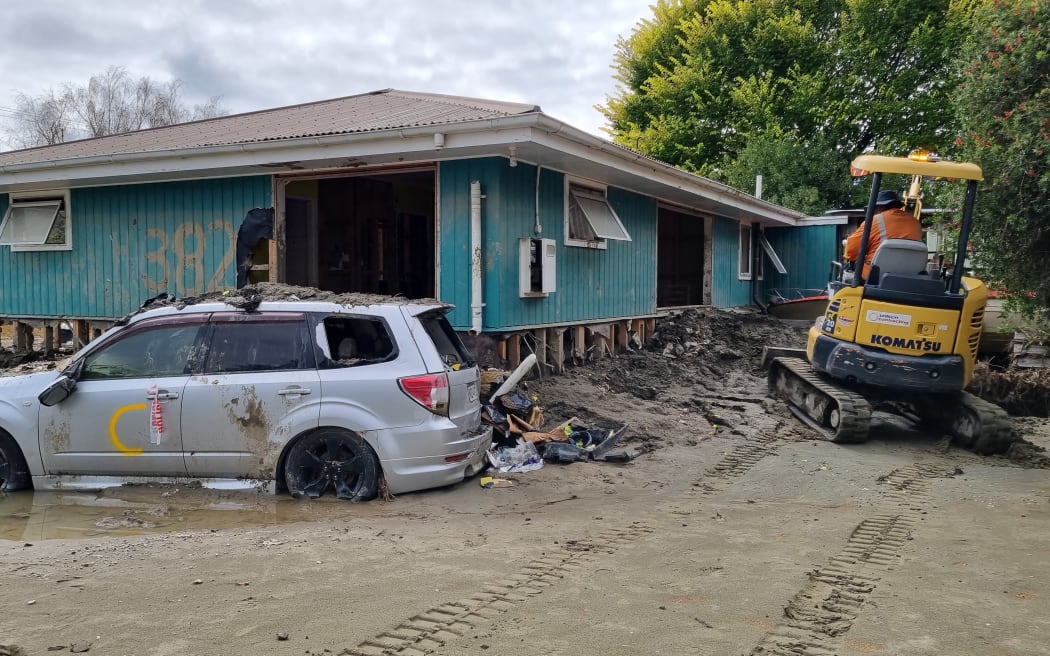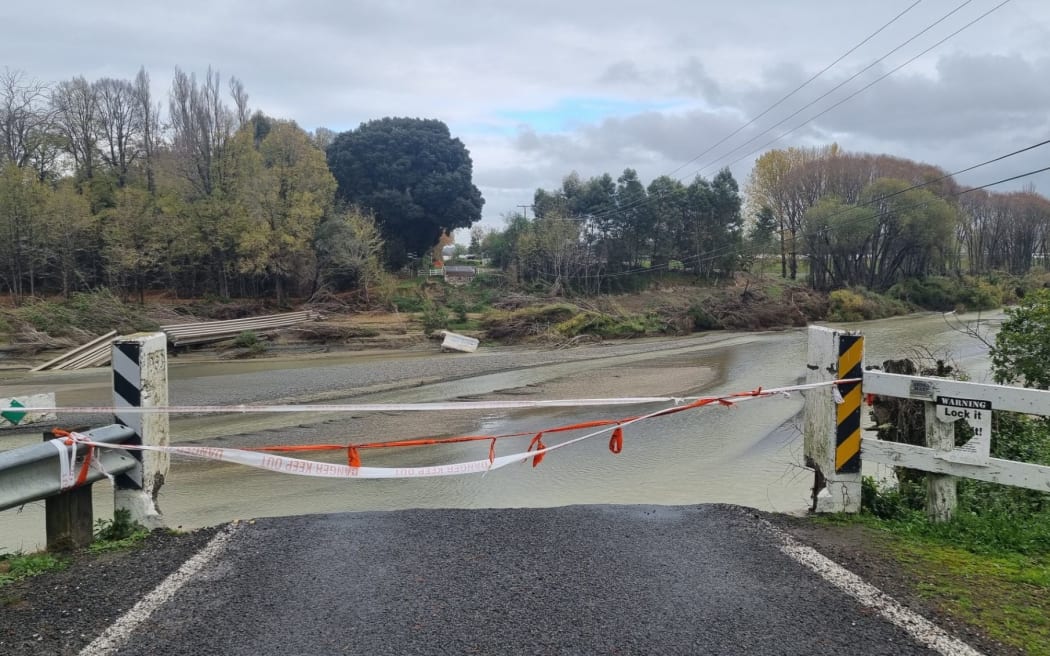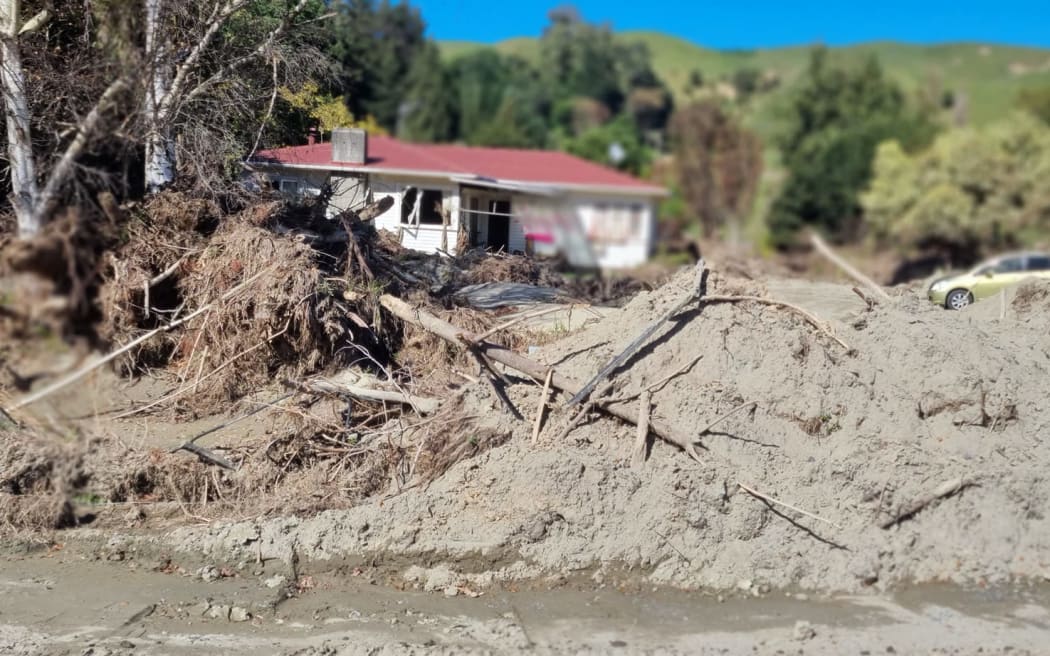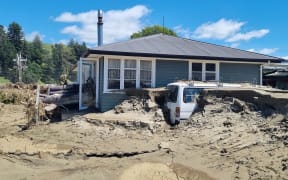
A yellow-stickered home in Esk Valley after Cyclone Gabrielle. Photo: RNZ / Robin Martin
The national emergency management system "sets up good people to fail", a review has found.
The findings and recommendations from an independent review of Hawke's Bay's Civil Defence response to Cyclone Gabrielle, headed up by former police commissioner Mike Bush, were made public on Monday afternoon.
The review investigated how well prepared Civil Defence was prior to the cyclone, as well as its immediate emergency response.
It found it was not well prepared for Cyclone Gabrielle, and the "worst case scenario" was not planned for.
Presenting the report to the Hawke's Bay Civil Defence Emergency Management Joint Committee - made up of the region's four mayors, the regional council chief executive, and mana whenua representatives - Mike Bush said the intent of those involved in the response was positive.
"It was absolutely clear that the severity, speed and scale of this disaster quite simply overwhelmed the officials involved in that response," he said.
Those involved did not have "situational awareness", which meant they did not plan for the worst case scenario, Bush said.

The media stand-up after the release of the findings of the independent review into Hawke's Bay Civil Defence Cyclone Gabrielle Response. From left Hastings Mayor Sandra Hazlehurst, Napier Mayor Kirsten Wise, Mana Ahuriri representative Leon Symes, Hawke’s Bay Regional Council chair Hinewai Ormsby, Central Hawke’s Bay Mayor Alex Walker, Ngāti Kahungunu chair Bayden Barber and Wairoa Mayor Craig Little. Photo: RNZ / Anusha Bradley
The report added: "Plans were as sound as any we have seen but lacked the operational detail needed to address an event of this scale and magnitude."
While the lack of power and communications made that harder, there should have been mitigations in place to get around that, he said.
There was a lack of capability within the response, said Bush - but he added that was not just a regional issue, coming down hard on the national system.
"We did find that the national emergency management system is not currently fit for purpose," he said.
"It actually sets up good people to fail."
A complete overhaul was needed, he said.
But he pointed out there were some things that went well.
"Governance across the region's emergency management was strong, and expectations were clearly set to officials.
"Their plans were robust."

Puketapu bridge in Hawke's Bay was swept away in Cyclone Gabrielle. Photo: RNZ / Lauren Crimp
The review panel gave 75 recommendations - nine 'Tier 1' priority recommendations, and 66 in 'Tier 2'.
The tier 1 recommendations include developing regional disaster reduction and readiness plans, building capability, and advocating to central government for an overhaul of the current CDEM system in New Zealand - including changed legislation, and systems and structures that better reflect and respond to the "current threatscape".
The committee agreed it would enlist the help of independent emergency management experts to develop an approach to carrying out the recommendations.
The review panel interviewed a range of individuals and organisations, bolstered by a public survey which attracted more than 1000 responses.
Report findings
The report laid out the main "lessons learned" from the response, including:
- Plans were "as sound as any we have seen" but lacked the operational detail needed to address an event of this scale and magnitude.
- Mayors, councils and partner agencies worked together well. Mayors were well versed in their responsibilities and powers and were proactive in fronting key messages to their communities.
- CDEM staff were overconfident about their readiness on the basis of prior emergency events such as Covid-19. They were operationally inexperienced and "suffered from optimism bias" - tending to take a best case scenario approach, rather than a precautionary approach to planning, communication and warnings.
- Communities, volunteers, the contractor sector, businesses and utility providers provided critical and heroic response activity. These local resources were not well utilised by the CDEM Group in the response to this event.
- Engagement of iwi Māori and Māori communities was ad hoc, rather than the product of systematic and formalised effort.
- Māori agencies and marae felt that their proven abilities to deliver welfare services at scale were either ignored or hampered by bureaucratic decision making from the Group Emergency Coordination Centre (GECC).
- There was inadequate river management prior to the event - including precautionary dredging to remove excess shingle, managing forestry slash, and flood protection maintenance.
- The GECC needed clearer protocols for engagement with other councils and with first responder command centres. Communications failures and the lack of integrated systems made it hard for responders to work to a common operating picture.
- The community thought GECC communications were generic, lacked timeliness and were overly focused on social media rather than mainstream media channels.
- The GECC did not have enough trained and confident controllers and staff, which led to inefficiencies, confusion and burnout.
- Civil Defence did not properly utilise available volunteer and community resources to support migrant, remote, disabled and vulnerable communities.
- State of emergency declarations were made too late, because the GECC gave mayors technical information, rather than communicating that a declaration would provide public reassurance.

Destruction caused by Cyclone Gabrielle at the Doggy Farmstay Boarding and Daycare in Esk Valley. Photo: Supplied / Katrina Harris
The region's leaders respond
The joint committee fully accepted the findings at Monday's meeting, and agreed to enlist the help of independent emergency management experts to develop an approach to carrying out the recommendations.
It admitted it was time to throw out the old model,= and start again.
"What is clear is that as a region, we need to be prepared to undertake a complete overhaul of our approach to civil defence to ensure that our communities are better prepared to manage or mitigate the devastating impacts of an event like Cyclone Gabrielle," it said in a statement.
There were "no silver bullets" but it was committed to developing a detailed action plan in the coming months, it said.
"To be clear, this is not about incremental change - we see this as a complete overhaul of how we approach emergency management in Hawke's Bay, and we intend to establish a dedicated workstream to ensure this important mahi is fully resourced with the support and expertise needed to deliver meaningful change for all of our communities for the future."
It had already begun making improvements, including a significant funding increase for Civil Defence resilience, establishing community hubs to better prepare rural and isolated communities for disasters, and training emergency management personnel.
Meanwhile, the National Emergency Management Agency still has not released its review into last year's North Island weather events, which was due in December.
It would likely do so in the next few weeks, and it was delayed because it was working to establish the causes of the issues it had identified, it told RNZ.
Its review was not "a system-wide review, rather it is a self-assessment of NEMA's response to the North Island Severe Weather Events", it said.
A report from the national inquiry into the North Island weather events, headed up by former Governor-General Sir Jerry Mateparae, is also due before Emergency Management Minister Mark Mitchell on Tuesday.
It was not yet clear when that would be released publicly.





